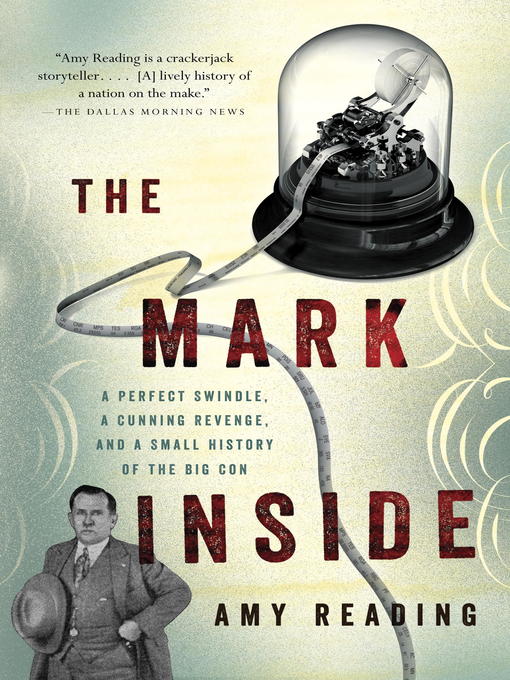
The Mark Inside
A Perfect Swindle, a Cunning Revenge, and a Small History of the Big Con
کتاب های مرتبط
- اطلاعات
- نقد و بررسی
- دیدگاه کاربران
نقد و بررسی

January 30, 2012
This account of con artists and obsessive revenge is replete with dramatic twists and turns. With a fierce work ethic, 54-year-old Texas Panhandle rancher J. Frank Norfleet had accumulated a small fortune by 1919, but he lost it in a stock swindle run by Big Joe Furey’s gang of con men. In the opening chapter, Reading outlines in detail the psychological manipulations that led Norfleet to fall for the swindle, and she follows with a chapter on the origins and history of confidence men. Sensing the indifference of law enforcement officials, Norfleet resolved to track down the swindlers himself, and succeeded. With the con men finally behind bars, Norfleet became a celebrity and borrowed the style of dime novels to write his 1924 autobiography, Norfleet: The Actual Experiences of a Texas Rancher’s 30,000-Mile Transcontinental Chase After Five Confidence Men, a key source for Reading, who in her first book delivers vibrant characterizations based on her research in archives, scrapbooks, newspapers, and government documents. This narrative of vigilante justice flows like fiction, as con artistry is illuminated throughout, with resonance in today’s world of high-tech con artistry. Agent: Simon Lipskar, Writers House.

January 15, 2012
A look at the art of the con, based on the story of a man who fought back against the con artists who swindled him. In 1919, J. Frank Norfleet, a 50-something Texas rancher, lost his wealth to a band of professional con men. Rather than swallow his losses or wait for the police to investigate, Norfleet decided to travel the United States wherever necessary to track down his swindlers and exact some sort of non-physical retribution. In a sometimes-dissonant mix of pop-culture and scholarly writing, Reading alternates among the Norfleet saga; the unreliability of memoirs, since she depends so heavily on Norfleet's own published accounts; and the larger context of how scammers have operated throughout American history. Despite the uneven narrative, the book is fascinating because Norfleet's quest seems both quixotic and inspiring. The prologue of the book is a con in itself, which Reading admits in the back matter. Otherwise, she writes, the book is entirely nonfiction, with every line of dialogue and atmospheric detail grounded in what she hopes is a reliable published source. Reading's doctoral dissertation focused on strategies of deception in American autobiographies, providing her with insights into how a researcher might separate truth from lie, strict accuracy from exaggeration. Norfleet is not the only notorious character from the period that Reading vividly portrays. Several of the men participating in the con were well known at the time, as were some of the law-enforcement officers who eventually helped Norfleet attain a modicum of justice. A worthwhile read for those interested in the underbelly of American history.
COPYRIGHT(2012) Kirkus Reviews, ALL RIGHTS RESERVED.

Starred review from February 15, 2012
Reading, who has a doctorate in American studies from Yale, offers a history of con artistry in the U.S. (Bernie Madoff has a long line of predatory predecessors, including a gentleman who duped Ben Franklin). This work, which puts deception in a sociological context from the settlement of the colonies on, is riveting, exciting, and eye-opening. The backbone of the book is Reading's retelling (the victim wrote an autobiography) of one of the most famous and elaborate con games in American history, the 1919 swindle, centering on the stock market, of Texas rancher J. Frank Norbert. Reading details all the vagaries of the swindle, involving a cast of characters, opulent settings, and what she describes as a tightly scripted drama with nine acts, and then gives readers the most amazing part of this case: after Norbert was left more than $1 million (today's currency) in debt, he devoted his life to tracking down his five swindlers, learning the tricks of the trade necessary to enter their world, and bringing them to justice. This analysis holds reader interest by interspersing the tale of the tricksters tricked with other examples of cons and, throughout, a consideration of what historical forces and sociological trends (such as the rise of big cities, giving con artists anonymity, and railroads, giving them an easy escape once the game was up) made the big con possible. Thoroughly researched and engagingly presented.(Reprinted with permission of Booklist, copyright 2012, American Library Association.)

























دیدگاه کاربران